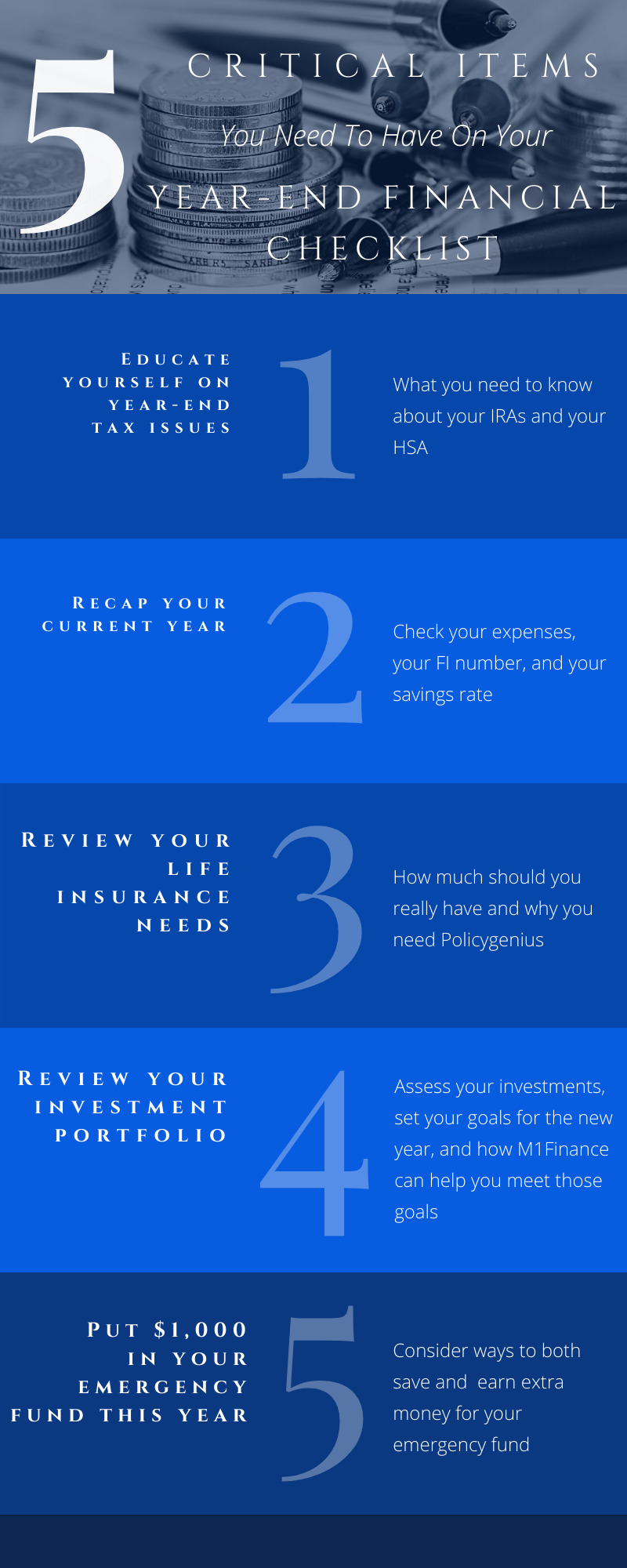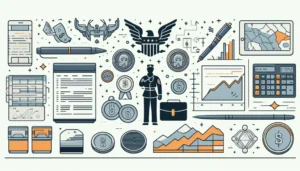When your goal is Financial Independence, you watch your spending and saving very carefully all year. But that doesn’t diminish the need for a year-end financial checklist.
On that checklist are things that you should do at the end of every single calendar year to make sure your finances are in the best shape possible before the start of a new year. Going through the checklist each year is a key habit to help you stay on your FIRE track.
Table of Contents
- Why You Need A Year-End Checklist
- Checklist Item #1: Educate Yourself On Year-End Tax Issues
- Checklist Item #2: Recap The Current Year
- Checklist Item #3: Review Your Life Insurance Needs
- Checklist Item #4: Review Your Investment Portfolio
- Checklist Item #5: Put $1,000 In Your Emergency Fund This Year
- Final Thoughts
Why You Should Use A Year-End Checklist
There are three reasons why using a year-end checklist makes good financial sense.
- Allows you to take advantage of year-end tax incentives. Contributions to your retirement account, last-minute deductions, and a quick check of your IRA distributions are just three of the ways that you can make sure you’re getting the best tax incentives.
- Helps you to set your financial goals for the new year. If you don’t know where you are in your finances, it’s virtually impossible to set new goals for the new year.
- Gives you a picture of your overall financial health. Just like it’s important to get a physical every year to make sure your body is healthy, it’s important to give your finances a check-up too to make sure that they’re in good shape.

Checklist Item #1: Educate Yourself On Year-End Tax Issues
Tax issues can be daunting for lots of people, both those who are new to FI and those who have been working towards FI for a while. It’s tempting to leave it off of your year-end financial checklist.
Don’t fall for the temptation. In this case, taxes don’t have to be complicated. You just have to know what to look for at the end of each year to make sure that you’re on the right track.
Roth IRA
Before we dig into the year-end stuff, here’s a refresher on what a Roth IRA is and who qualifies to have one. This is important because there are certain income qualifications you cannot exceed in order to have a Roth IRA.
Contribution Deadline
You have until April 15 of the coming year to make a contribution to your Roth IRA for this year. Confusing, we know, but it’s the rule. For instance, you have until April 15, 2021, to make a contribution to your Roth IRA for the calendar year 2020.
Please note that if you file an extension for your taxes, you do not get an extension on the Roth IRA contribution deadline. It’s still April 15.
This deadline will benefit you if you like to file your taxes early. Do that, and you’ll still have plenty of time to contribute part or all of your refund into your Roth IRA.
Tax Deduction
Generally, Roth IRA contributions are not tax-deductible. However, if you meet certain income qualifications, you might qualify for future tax credits on some of that money in your Roth IRA. Here are the guidelines as to who qualifies for tax credits.
Backdoor Roth IRA
Sean Mullaney, the FI Tax Guy, says Roth conversions are something that should always be considered as part of your year-end financial checklist. A Roth conversion is when you transfer assets from a traditional IRA to a Roth IRA. It’s also called a Backdoor Roth IRA.
You can listen to Sean share his thoughts on Roth conversions on this episode of the ChooseFI podcast. He states that he’s never met someone who thought they had converted too much money, so Sean advocates converting as much as you can. The conversion is a taxable event so it might cost you some money upfront to do it, but it also might save you more on taxes later on.
The deadline for Roth conversion is December 31.
HSA
An HSA is a Health Savings Account. Healthcare.gov defines it as “a type of savings account that lets you set aside money on a pre-tax basis to pay for qualified medical expenses.” The benefit of this is that it might save you money when you’re paying for your medical bills, deductibles, etc.
The IRS sets certain limits as to how much you can contribute based on if you have single coverage or family coverage. Know what your limits are because if you go over them, you’ll be forced to pay a penalty in taxes. HSAs do carry over from year to year, so you don’t have to worry about losing any unspent funds at the end of the year.
Like with your Roth IRA, you can contribute to your HSA up through April 15 of the new calendar year. So you can contribute to your 2020 HSA through April 15, 2021.
Roth 401(k)
A Roth 401(k) combines the best of the Roth IRA and 401(k) worlds. It’s an employer-sponsored investment savings account that is funded by your after-tax contributions. That means that, unlike a regular 401(k), there are no tax penalties when you withdraw your money from a Roth 401(k).
You still have to start taking required minimum distributions from the Roth 401(k) by the time you reach a certain age (72 or 70 1/2, depending on when you were born) just like with a traditional 401(k). However, with a Roth 401(k), you can choose to roll the funds over into a Roth IRA, which has no minimum required distribution.
The contribution deadline for your Roth 401(k) is also April 15 of the next year.
Checklist Item #2: Recap The Current Year
Analyzing the current year before it ends is crucial to your year-end financial checklist to ensure that you’re either on the right financial track or to reveal what adjustments need to be made to get you back on track in the new year.
Review Your Expenses
Ask yourself the following questions as part of your year-end financial review:
Were there any significant unplanned expenses?
If not, pat yourself on the back. If so, track them to understand why. Make a note of how large those expenses were and whether you were able to handle them without drastically altering your savings. Ask yourself if the unplanned expenses you had should be considered and planned for in the new year. If so, add them in to your budget.
Where can you cut any expenses going into the new year?
Year-end is a fantastic time to assess your expenses, so make some changes to your budget. Do you have subscriptions to services that you’re not using? Memberships to gyms or clubs that aren’t necessary anymore? Can you pay off any debt that you’re carrying?
Be honest with yourself about what you need and what you don’t, and then unsubscribe from or cancel what you’re not using. The small sacrifice now will contribute to the big payoff later of retiring early.
Do you have any big known expenses in this upcoming year?
Knowing the future is impossible, of course, but taking a few minutes to think through the next year might reveal some things that hadn’t occurred to you before.
Do you have an elective surgery that can’t be put off anymore? How about a home improvement project like new windows or a new furnace or water heater? Have you finally decided now is the right time to get the puppy your kids have been begging you to get for them?
Consider all of these known expenses, then do your best to budget for them throughout the year. This will ensure that no one thing sets you back and puts you into debt, but rather that your finances are set up to absorb larger hits.
Calculate (Or Re-Calculate) Your FI Number
Your FI Number is the amount of money you need to have saved in order to retire. The simplest way to get this number is to add up your annual expenses, then multiply them by 25. For instance, if your annual expenses are $30,000, your FI number would be $750,000.
Obviously this number has the potential to change every year. If you pay off any of your debt, your expenses are clearly going to decrease. If your expenses decrease, your FI number will too. Knowing this will help you adjust your financial strategies for the new year.
Check Your Savings Rate From The Current Year
Savings rates are always changing. If you have your money in an online bank, do your research on the best online banks. How does your bank compare with those on this list? Are you getting the most out of your money?
Sometimes simple changes can make a huge difference. Shifting your savings from one bank to another to get a better rate is one of those simple changes.
Checklist Item #3: Review Your Life Insurance Needs
Some people treat life insurance with a “get it and forget it” mentality. FIers know better. We know that your year-end financial checklist must include a review of your current life insurance policy so that you can be sure you’re not overpaying for coverage that you no longer need.
Reference Your FI Number
As your savings increases each year, you will need less life insurance should a disaster occur. Therefore, you can afford to gradually cut back each year on the amount of life insurance that you carry.
Check your new FI number, then subtract the amount you have in savings. What’s left is what you need to cover with your life insurance.
For instance, if your FI number is $750,000 as in our example above and you have a $350,000 net worth, you only need to have a $400,000 life insurance policy. So if you originally purchased a $1,000,000 policy, you’re paying for something you don’t really need.
Shop Policygenius For The Best Life Insurance Rates
Once you know how much life insurance you need, it’s time to shop around. Your search should start (and will likely end) with Policygenius.
We here at ChooseFI love Policygenius because it’s a one-stop shop for your life insurance needs. Instead of spending hours visiting website after website to see which plan is the least expensive with the best coverage, let this one site do all the work for you.
Check out our review of Policygenius, which also includes ways that you can decrease the cost of your life insurance by making simple changes to the way you live. January is the time of year when most people buy life insurance or make changes to their current policy. Join the crowd and make your updates to save yourself money!
Checklist Item #4: Review Your Investment Portfolio
A key piece of staying the course to FI is knowing what’s going on with all of your investments. Your year-end financial checklist would be incomplete without a comprehensive look at your investment portfolio.
Assess Your Current Investments
Ask yourself these three questions to assess your investments at the end of each year.
Did you meet your investment goals?
This is a simple examination of your portfolio’s bottom line. What were your goals for your assessments going into this current year? Did you meet them?
If you did, great! Consider whether it’s prudent to stay the course or switch things up a bit to try to earn even more. If you didn’t meet your goals, where did you fall short, and do you see why?
Are your assets allocated well?
A good portfolio has your assets allocated in different places to ensure diversification and a good return. You should have a mix of stocks, money markets, bonds, etc. Check out how each has performed this year to see if your allocation needs more attention.
Do you have enough liquidity in your investments?
The answer to this question is more important to some FIers than to others. For some, their investments are meant to just continue to (hopefully) make money, and there’s no plan to touch those investments for a long time.
For others who believe in a less traditional emergency fund model, having assets that are easily liquidated is very important. Those people are using their investment monies as their emergency fund, so it must be quickly accessible.
Set Your Investment Goals For The Coming Year
Part of your year-end financial checklist should include looking ahead to next year. What do you want to accomplish with regards to your investments? Do you have a specific dollar amount that you want to hit? Do you know where you want to be on your FI path at the end of next year?
Setting those goals now will help you make decisions about your assets and investments in the coming year. You might be willing to take a bigger risk if you’re looking for a bigger return or play it safe if you’re content with the speed that you’re approaching FI.
How M1 Finance Can Help
Knowing how to invest, when to invest, where to invest – these can all be really complicated. M1 Finance is a free robo-advisor that helps you decide where to invest your money. You choose from their list of investment options, including fractional shares that allow you to invest even small amounts of money to start building your assets. With literally a few clicks, your money is invested and you can sit back and watch it build.
Check out this video tutorial to learn more about M1 Finance and how it works.
Checklist Item #5: Put $1,000 In Your Emergency Fund This Year
A critical piece of FI is having an emergency fund. Emergencies are inevitable. Having a fund to deal with them can give you a sense of pride that you can pay in cash for these unexpected expenses. Your emergency fund might also save you from financial ruin.
Making sure your fund is robust enough to cover what you might need is really important. Experts vary on how much you need to have in the fund. Estimates go from enough to cover a few months’ worth of expenses to enough to cover an entire year of expenses.
Wherever you land on that spectrum of savings, it’s never a bad idea to pad your emergency fund with a little extra cash. Make it a goal to add $1,000 to your emergency fund this year.
Cut Expenses To Save Money
Remember when we discussed reviewing your expenses? Consider canceling subscriptions or cutting your grocery budget. Make it a goal to not buy takeout or coffee from a coffee shop for a whole month. Then take those savings and put them right into your emergency fund.
Start really going through your expenses with a fine-tooth comb if you haven’t already. As you do, you might be surprised at how much money you find that you can put towards that goal of $1,000.
Earn Extra Money
If you’ve gone through your expenses and can’t cut any more, consider trying to earn extra money through a side hustle.
ChooseFI has long advocated having a side hustle as a way to achieve FI sooner and even has a list of short-term side hustles that might work for you. The key is to choose what’s right for your skillset and what fits your schedule, then get to work.
If you love to drive, consider doing it for Uber or Lyft on nights or weekends. Are you a good writer? Pick up a few clients that you can write articles for in your time off from work. Do you love animals? Then become a dog-walker or a pet-sitter. All of these can easily bring in $1,000 in one year.
Final Thoughts
The end of the year can be a busy time with celebrations and get-togethers and time with family and friends. But in the midst of all of your busyness, please don’t neglect the important task of completing your year-end financial checklist. It can mean all the difference in the world in getting the new year off to a good financial start.



